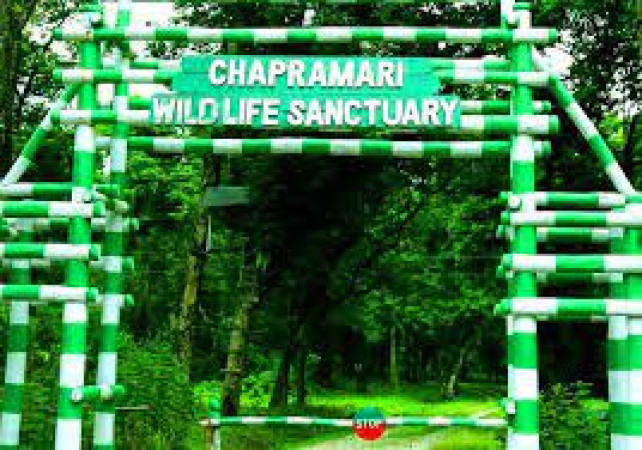
Chapramari Wildlife Sanctuary
Dooars . West Bengal . India
Duration
1 to 2 Days
1 to 2 Days
Best time to visit
Nov-Mar
Nov-Mar
Theme
Wildlife
Wildlife
Chapramari Wildlife Sanctuary Travel Guide
Chapramari Wildlife Sanctuary, located in the foothills of the Eastern Himalayas in West Bengal, India, is a nature lover's paradise. Established in 1895, this sanctuary is renowned for its diverse flora and fauna, including rare species like the Royal Bengal Tiger and Asian Elephant. The sanctuary's lush greenery, tranquil rivers, and breathtaking landscapes make it a must-visit destination for wildlife enthusiasts and nature photographers.Top Attractions in Chapramari Wildlife Sanctuary
- Jeep Safari through the dense forest
- Bird watching at the sanctuary's numerous bird species
- Spotting the elusive Royal Bengal Tiger in its natural habitat
- Exploring the watchtower for panoramic views of the sanctuary
Chapramari Wildlife Sanctuary is Famous for
Its diverse wildlife and pristine natural beauty.Top Attractions in Chapramari Wildlife Sanctuary
- Jeep Safari through the dense forest
- Bird watching at the sanctuary's numerous bird species
- Spotting the elusive Royal Bengal Tiger in its natural habitat
- Exploring the watchtower for panoramic views of the sanctuary
What's Great about Travelling to Chapramari Wildlife Sanctuary?
- Perfect destination for nature lovers
- Great opportunity for wildlife photography
- Peaceful and serene environment
What's Not So Great about Travelling to Chapramari Wildlife Sanctuary?
- Limited accommodation options
- Remote location may require long travel hours
- Strict rules to maintain the sanctuary's natural habitat
Travel Tips for Chapramari Wildlife Sanctuary
- Obtain necessary permits before entering the sanctuary
- Wear comfortable clothing and sturdy shoes for jungle treks
- Respect the wildlife and follow the park rules
Important Chapramari Wildlife Sanctuary trip information
- Ideal Duration: 2-3 days
- Best Time to Visit: October to March
- Nearby Airports and Railway Stations: Bagdogra Airport and New Mal Junction Railway Station
FAQ's on Chapramari Wildlife Sanctuary
Q1: What is the best time to visit Chapramari Wildlife Sanctuary?
The best time to visit Chapramari Wildlife Sanctuary is during the winter months from November to February when the weather is cool and pleasant. This period is ideal for wildlife sightings and exploring the lush greenery of the sanctuary. Avoid the monsoon season from June to September due to heavy rainfall which can make the trails muddy and difficult to navigate.
Q2: Do I need a visa to travel to Chapramari Wildlife Sanctuary?
As Chapramari Wildlife Sanctuary is located in India, tourists will need a valid Indian visa to visit the sanctuary. Make sure to check the visa requirements based on your nationality before planning your trip. Some nationalities may be eligible for e-visas or visa on arrival, so it's essential to verify the specific requirements.
Q3: What are the must-visit attractions in Chapramari Wildlife Sanctuary?
Chapramari Wildlife Sanctuary is known for its rich biodiversity and stunning natural beauty. Some of the must-visit attractions include the watchtower for excellent wildlife viewing, the picturesque Murti River, and the diverse flora and fauna of the sanctuary. Wildlife enthusiasts should keep an eye out for elephants, deer, and various bird species.
Q4: Is Chapramari Wildlife Sanctuary a safe place to travel?
Chapramari Wildlife Sanctuary is generally safe for tourists, but it's essential to follow safety guidelines provided by local authorities. Avoid venturing into restricted areas, maintain distance from wild animals, and always travel with a guide. Be cautious of your surroundings and belongings to ensure a safe and enjoyable visit.
Q5: What is the local currency in Chapramari Wildlife Sanctuary and can I use credit cards?
The local currency in Chapramari Wildlife Sanctuary is the Indian Rupee (INR). While credit cards are accepted in some hotels and larger establishments, it's advisable to carry cash for smaller purchases and transactions. ATMs may not be readily available in the sanctuary, so it's recommended to withdraw cash beforehand.
Q6: What is the local cuisine like in Chapramari Wildlife Sanctuary?
The local cuisine in Chapramari Wildlife Sanctuary offers a mix of traditional Indian dishes with flavors unique to the region. Try local favorites like momos (dumplings), thukpa (noodle soup), and traditional Bengali sweets. Vegetarian options are widely available, and it's advisable to inform restaurants of any dietary restrictions.
Q7: What transportation options are available in Chapramari Wildlife Sanctuary?
Transportation options in Chapramari Wildlife Sanctuary include local buses, private taxis, and hired vehicles. Visitors can also opt for guided safaris within the sanctuary for a closer look at the wildlife. It's recommended to arrange transportation in advance, especially during peak tourist seasons.
Q8: Are there any cultural norms or etiquette I should be aware of when visiting Chapramari Wildlife Sanctuary?
When visiting Chapramari Wildlife Sanctuary, it's important to respect the local customs and traditions. Dress modestly, especially when visiting religious sites, and always ask for permission before taking photographs of locals. Avoid littering and be mindful of wildlife habitats to minimize your impact on the environment. Embrace the local culture with an open mind and enjoy your experience in the sanctuary.
Q9: I am a travel agent. How can I buy travel leads of Chapramari Wildlife Sanctuary?
Register yourself as a travel agent at agents.tripclap.com and then you can buy travel leads to Chapramari Wildlife Sanctuary once your account is approved. For more details contact our support team at +91-8069186564 or support@tripclap.com
